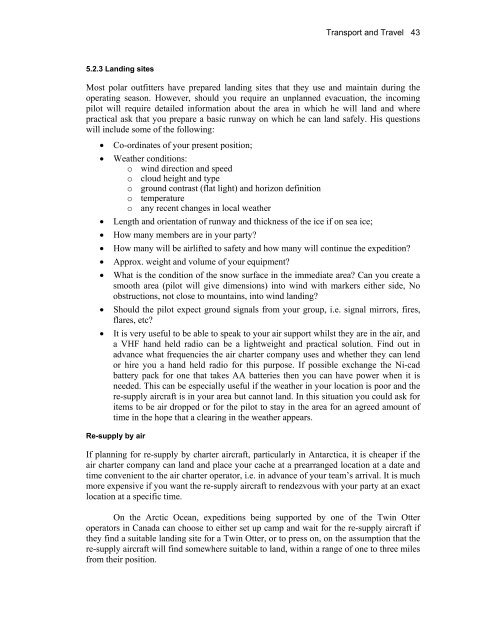Edited by Rachel Duncan 4th Edition ISBN 0-907649-91-2 London ...
Edited by Rachel Duncan 4th Edition ISBN 0-907649-91-2 London ...
Edited by Rachel Duncan 4th Edition ISBN 0-907649-91-2 London ...
Create successful ePaper yourself
Turn your PDF publications into a flip-book with our unique Google optimized e-Paper software.
5.2.3 Landing sites<br />
Transport and Travel 43<br />
Most polar outfitters have prepared landing sites that they use and maintain during the<br />
operating season. However, should you require an unplanned evacuation, the incoming<br />
pilot will require detailed information about the area in which he will land and where<br />
practical ask that you prepare a basic runway on which he can land safely. His questions<br />
will include some of the following:<br />
• Co-ordinates of your present position;<br />
• Weather conditions:<br />
o wind direction and speed<br />
o cloud height and type<br />
o ground contrast (flat light) and horizon definition<br />
o temperature<br />
o any recent changes in local weather<br />
• Length and orientation of runway and thickness of the ice if on sea ice;<br />
• How many members are in your party?<br />
• How many will be airlifted to safety and how many will continue the expedition?<br />
• Approx. weight and volume of your equipment?<br />
• What is the condition of the snow surface in the immediate area? Can you create a<br />
smooth area (pilot will give dimensions) into wind with markers either side, No<br />
obstructions, not close to mountains, into wind landing?<br />
• Should the pilot expect ground signals from your group, i.e. signal mirrors, fires,<br />
flares, etc?<br />
• It is very useful to be able to speak to your air support whilst they are in the air, and<br />
a VHF hand held radio can be a lightweight and practical solution. Find out in<br />
advance what frequencies the air charter company uses and whether they can lend<br />
or hire you a hand held radio for this purpose. If possible exchange the Ni-cad<br />
battery pack for one that takes AA batteries then you can have power when it is<br />
needed. This can be especially useful if the weather in your location is poor and the<br />
re-supply aircraft is in your area but cannot land. In this situation you could ask for<br />
items to be air dropped or for the pilot to stay in the area for an agreed amount of<br />
time in the hope that a clearing in the weather appears.<br />
Re-supply <strong>by</strong> air<br />
If planning for re-supply <strong>by</strong> charter aircraft, particularly in Antarctica, it is cheaper if the<br />
air charter company can land and place your cache at a prearranged location at a date and<br />
time convenient to the air charter operator, i.e. in advance of your team’s arrival. It is much<br />
more expensive if you want the re-supply aircraft to rendezvous with your party at an exact<br />
location at a specific time.<br />
On the Arctic Ocean, expeditions being supported <strong>by</strong> one of the Twin Otter<br />
operators in Canada can choose to either set up camp and wait for the re-supply aircraft if<br />
they find a suitable landing site for a Twin Otter, or to press on, on the assumption that the<br />
re-supply aircraft will find somewhere suitable to land, within a range of one to three miles<br />
from their position.

















